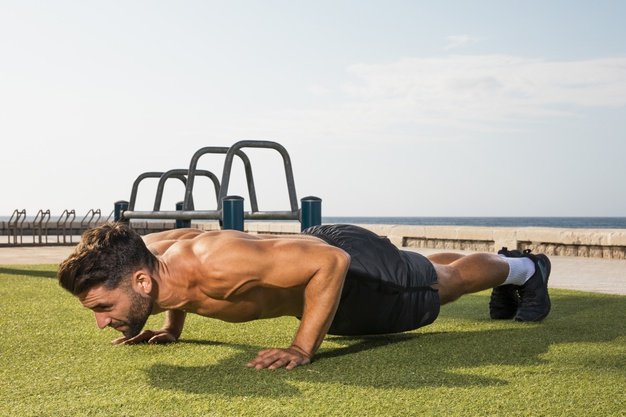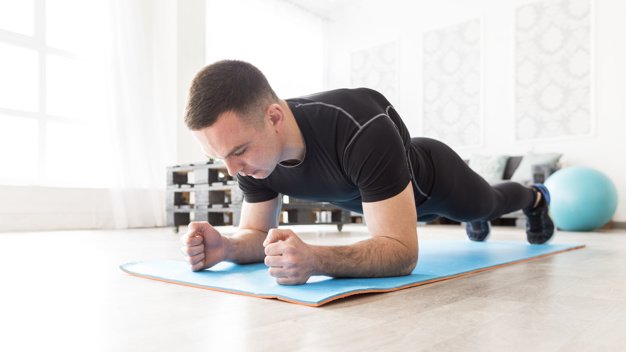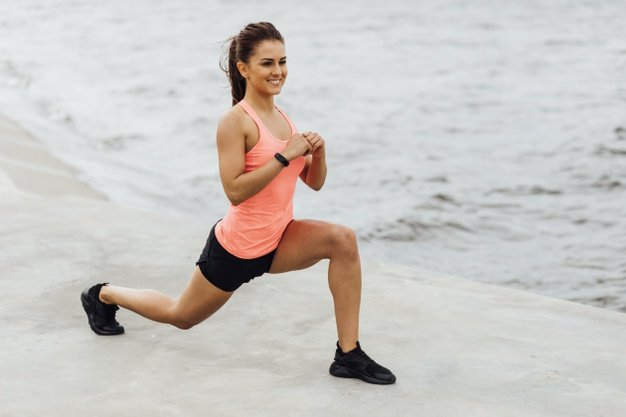All exercises are not treated equally. Some exercises are meant for building muscle and strength and most of us think that the only way we can do that is by picking up a pair of heavyweights at the gym. But the truth is you can build muscle and strength at home too and without picking any weight, just picking up your own body weight can notch up your muscle-building strength way higher!
Yes, we know that most of us do not have enough time to exercise at the gym, “I am just too busy.” That’s the excuse we all give, but what if you can exercise your whole body with simple body moves? Just a few minutes of your daily routine and you are pretty much sorted. Try this ultimate muscle and strength building workouts to get a lean and ripped body. These 10 moves are all you need!
Ultimate Muscle and Strength Building Exercise – 10 Mean Moves
1. Pushup:
The push-up is a great bodyweight exercise and works on a lot of muscles altogether such as the shoulders, the chest, and triceps muscles.
Here is how you do it :
Drop down to all fours keeping your feet together, keep your hands under your shoulders and keep your body aligned straight from the head to ankles. With your elbows tucked in, lower down your body until your chest is close to the floor but does not touch it.
2. Deep Squat:
Deep squats help in overall muscle development in the lower body working on a lot of muscles together such as quads, glutes, and hamstrings for overall muscle growth.
Here is how you do it:
Keep your feet at least shoulder-width apart and extend your arms straight out. Push your hips back and squat as much as you can.
3. Planks:
Planks are a great way to strengthen all your core muscles, some of the muscles worked are the rectus abdominis, the adductor complex the external oblique muscle, and the glutes.
Here is how you do it:
Drop into a push-up position on the floor. Bend your elbows and balance your weight on your forearms. Keep the alignment of your body right from shoulders to ankles. Brace your abdominal muscles while inhaling and exhaling slowly. Hold this position for another 20-40 seconds and keep at it for as long as you can. Lower yourself to the ground. Repeat this for at least 3 or 4 times.
4. Squat Jack:
Squat Jacks are a great lower-body exercise that works on a number of muscles such as quads, glutes, and hamstrings.
Here is how you do it:
Put your feet together and use your hands to touch the sides of your ankles. Now get into a standing position and raise your head and jump into your sides.
5. Mountain Climber:
Mountain Climbers are a great exercise to move your heart rate up and working up most muscle groups in the body such as the chest, obliques, deltoids, biceps, triceps, quads, abdominals, hamstrings, and hip abductors.
Here is how you do it:
Get down to a pushup position. Bring your right foot and bring it as close to your chest as possible, touching the floor with the help of your right foot. Repeat the entire exercise with your other leg That completes 1 rep.
6. Single-Leg Hip Hinge:
The single-leg hip hinge works your glutes and hamstrings and it boosts your foot and ankle strength to a great extent. It also improves your balance and stabilization.
Here is how you do it:
Stand on your right leg and raise your left foot behind you, keep your arms by your sides. Next, while you push your hips back try and reach for the floor as you lower your upper body and raise your left leg. Try and go for 10 movements per leg.
7. Skater Hop:
The skater jump works your quads, your hamstrings, glutes, and calves. This workout tones your entire leg.
Stand on your right foot with your left leg crossed behind you. When you land on your left foot try to cross your right leg behind you. Keep hopping from one leg to another.
8. Bridges:
The bridge is an exemplary exercise that works all your core muscles that includes your abs, lower back, and also tones your glutes. The Bridge also stretches out your chest, neck, spine, and hips and helps with pain in your back, head, and knee.
Here is how you do it:
Lie down flat on your back. Bend your knees while keeping your feet on the floor and keep your arms relaxed right beside you. Lift the butt off the floor all the while tightening your glutes and abs. Hold this position for a minute and reprise your original position.
9. Lunge:
The lunge is a great functional exercise. It works your glutes in your hips and butt and also works the hamstrings and quadriceps in your thighs beside the calf muscles in your legs.
Here is how you do it:
Keep your feet shoulder-width apart all the while keeping the upper body upright and look forward. Take a step forward with one foot, then bend the front knee at a 90-degree angle. Ensure that your front knee is right below the ankle when you perform this exercise.
10. Jump Squats:
The jump squat specifically works the legs and midsection. The specific muscles it works are the hamstrings, gluteus maximus, abdominals, quadriceps, and calves, by continuously stretching and contracting the muscles.
Here is how you do it:
Keep your feet hip-width apart and rest your arms at your sides. Squat low all the while keeping your back straight and core all braced up. Use your hips, knees, and ankles to explode up. Use your hands to get the extra momentum. Land with a soft jump keeping your bent knees aligned with your hips and ankles. Land and immediately go for your next jump.
There, how difficult can it be to do all the exercises? You can do these exercises in a HIIT format or interval training format. Do at least 5-10 minutes of warm-up exercises before starting. That means 30 seconds of work with 60 seconds of rest. This will give you great results in a short time! Try out all these exercises and let me know if you have felt the difference. Happy working out!
Read Also :






























